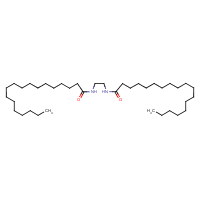N,N'-Ethylene distearylamide
Agent Name
N,N'-Ethylene distearylamide
Alternative Name
Acrawax C
CAS Number
110-30-5
Formula
C38-H76-N2-O2
Major Category
Nitrogen Compounds

Synonyms
Acrawax C; N,N'-1,2-Ethanediylbisoctadecanamide; N,N'-Ethylene bisstearamide; 1,2-Bis(octadecanamido)ethane; Abril wax 10DS; Acrawax CT; Advawachs 280; Advawax; Advawax 275; Advawax 280; Armowax EBS-P; Carlisle 280; Carlisle Wax 280; Chemetron 100; Ethylenebis(stearamide); Ethylenebis(stearylamide); Ethylenebisstearoamide; Ethylenediamine bisstearamide; Ethylenediamine steardiamide; Ethylenedistearamide; Kemamide W 40; Lubrol EA; Microtomic 280; N,N'-Distearoylethylenediamine; N,N'-Ethylenebis(stearamide); N,N'-Ethylenedistearamide; Nopcowax 22-DS; Octadecanamide, N,N'-1,2-ethanediylbis-; Octadecanamide, N,N'-ethylenebis-; Plastflow; Stearic acid, ethylenediamine diamide; WAX C; [ChemIDplus] N-(2-Octadecanoylaminoethyl)octadecanamide; [SIDS UNEP]
Category
Other Nitrogen Compounds
Description
White waxy solid; [ICSC] Commercial product: White to light brown solid; [SIDS UNEP] White to light yellow powder; [Clariant MSDS]
Sources/Uses
Used as a plastic lubricant, extender or substitute for carnauba wax, mold release agent for rubber compounding, defoamer, and heat stabilizer for plastics; [HSDB] Used as a powder lubricant for metal and plastics and in varnishes and mar-resistant paints; [Hawley] Comprises 40% of the commercial product, with the balance being 40% N-(2-Octadecanoylaminoethyl)hexadecanamide (CAS # 5136-44-7), 13% N-(2-Hexadecanoylaminoethyl)hexadecanamide (CAS # 5518-18-3), and the remainder is other fatty acid amides and residual fatty acids; [SIDS UNEP]
Comments
Dust mixtures with air may be explosive; A mild skin, eye, and respiratory tract irritant; [ICSC] No mortality, clinical signs of toxicity, or abnormalities found at necropsy in oral lethal-dose studies of rats at 2,000 mg/kg (secondary literature reports oral LD50’s for rats as high as >20,000 mg/kg); Causes mild skin and eye irritation in rabbits; No significant adverse effects observed in three 28-day oral studies of rats (doses up to 1,000 mg/kg/day); Adverse effect on growth observed in 15-week and 2-year feeding studies of rats; No evidence of mutagenicity, teratogenicity, reproductive, or developmental toxicity; [SIDS UNEP] May cause eye irritation; [Clariant MSDS]
Biomedical References
Exposure Assessment
Diseases, Processes, and Activities Linked to This Agent
Processes
Industrial Processes with risk of exposure: